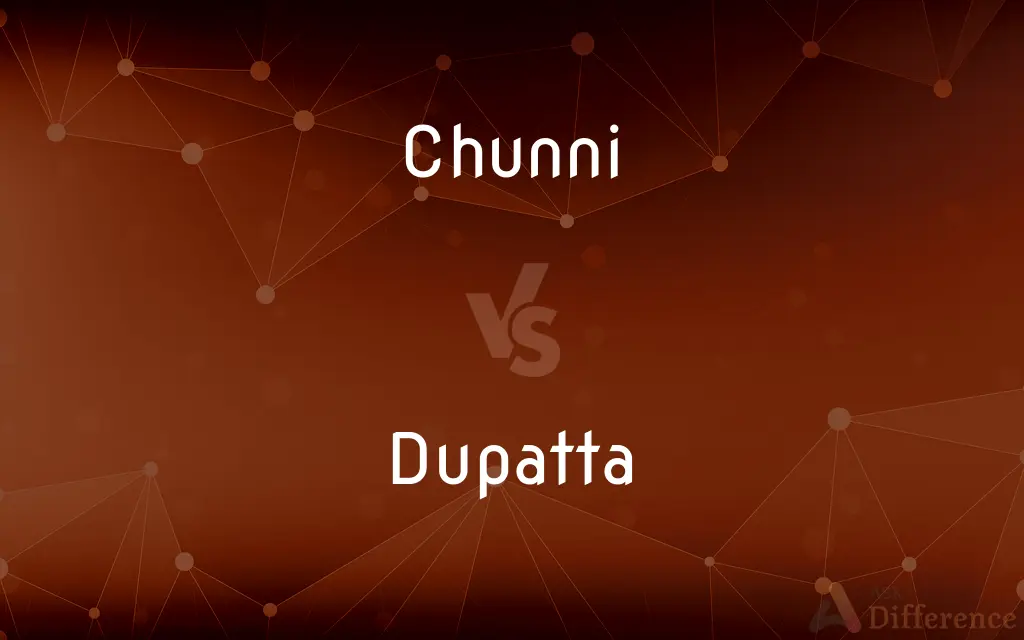Chunni vs. Dupatta — What's the Difference?
By Tayyaba Rehman — Updated on October 29, 2023
Chunni is a lighter, narrower scarf, often part of a traditional outfit; Dupatta is broader, longer, and draped with salwar kameez or lehengas.

Difference Between Chunni and Dupatta
Table of Contents
ADVERTISEMENT
Key Differences
Chunni is typically a lighter, narrower piece of cloth, often worn with traditional Indian outfits like suits and kurtis. Dupatta, on the other hand, is a broader and longer scarf, usually paired with salwar kameez or lehengas.
In terms of fabric, chunni is often made from lighter materials and can be more casual in appearance. Dupatta, conversely, is frequently made from richer fabrics and is used for formal occasions.
While a chunni is generally used for everyday wear and has a functional aspect, covering the head or shoulders, a dupatta is more decorative and is an integral part of formal attire.
The styling also differs; a chunni can be simply draped around the neck or over the shoulders. In contrast, a dupatta is often elegantly draped over both shoulders and can be styled in various ways.
Lastly, chunni is often associated with simpler, everyday outfits, whereas a dupatta is linked with more elaborate, ceremonial, and festive attire.
ADVERTISEMENT
Comparison Chart
Width
Narrower
Broader
Length
Shorter
Longer
Usage
Casual, everyday wear
Formal, ceremonial wear
Fabric
Lighter materials
Richer, heavier fabrics
Styling
Simple drape
Elaborate, varied draping
Compare with Definitions
Chunni
An accessory for modesty and style in Indian dress.
Her chunni gracefully covered her head during the ceremony.
Dupatta
An elegant accessory for formal South Asian attire.
She draped her silk dupatta for the wedding.
Chunni
A casual scarf for daily wear in South Asian fashion.
She chose a cotton chunni for her daily chores.
Dupatta
A long, broad scarf for traditional Indian outfits.
Her lehenga was complemented by an embroidered dupatta.
Chunni
A traditional Indian scarf, often part of a set.
The chunni matched her suit perfectly.
Dupatta
A formal scarf, often rich in fabric and design.
For the festival, she chose a dupatta with golden borders.
Chunni
A light, narrow scarf worn with Indian attire.
She paired her kurti with a vibrant chunni.
Dupatta
A versatile, often decorative scarf in Indian fashion.
Her dupatta added a pop of color to her outfit.
Chunni
A versatile piece of cloth, used for head or shoulder covering.
On sunny days, she used her chunni to shield from the sun.
Dupatta
A piece of cloth, symbolizing grace in Indian wear.
Her graceful walk was accentuated by the flowing dupatta.
Chunni
A long scarf worn by South Asian women.
Dupatta
The dupattā is a shawl traditionally worn by women in South Asia. The dupatta is currently used most commonly as part of the women's shalwar kameez outfit, and worn over the kurta and the gharara.
Dupatta
A long wide scarf often worn draped over the head or across the shoulders, chiefly by women in South Asia.
Dupatta
(South Asia) A double layer of cloth worn by women as a scarf, veil etc.
Common Curiosities
What is a chunni?
A chunni is a narrow, light scarf typically worn with traditional Indian outfits.
What is a dupatta?
A dupatta is a long, broad scarf, often worn with formal Indian attire like salwar kameez or lehengas.
Are dupattas only for special occasions?
Dupattas are usually for formal or ceremonial occasions but can be worn casually too.
Can a chunni be part of a matching outfit?
Yes, chunnis often match the color and pattern of Indian suits or kurtis.
Do dupattas come in different designs?
Yes, dupattas vary in design, from simple to heavily embroidered or embellished.
Is there a cultural significance to wearing a chunni?
In some cultures, chunnis signify modesty and are a part of traditional dress codes.
What occasions are chunnis worn for?
Chunnis are usually worn for casual or daily wear.
Can chunnis and dupattas be made of the same fabric?
Yes, but chunnis are typically made of lighter materials, while dupattas often use richer fabrics.
Is a chunni essential for traditional Indian outfits?
While not essential, a chunni often completes the look of traditional Indian outfits.
How do you style a dupatta?
Dupattas can be draped over both shoulders, around the neck, or in other elaborate styles.
Can a chunni be used for purposes other than fashion?
Yes, a chunni can also serve functional purposes like covering the head or shoulders.
Do men wear chunnis or dupattas?
Generally, no. Both chunnis and dupattas are primarily worn by women.
Can dupattas be worn with Western clothing?
While unconventional, some people style dupattas with Western outfits for a fusion look.
Are dupattas always long and broad?
Traditionally, yes, but contemporary fashion might offer variations in size.
Are chunnis and dupattas exclusive to certain regions?
They are predominantly worn in South Asian countries but have gained popularity globally.
Share Your Discovery

Previous Comparison
Software vs. Tool
Next Comparison
Carton vs. PackageAuthor Spotlight
Written by
Tayyaba RehmanTayyaba Rehman is a distinguished writer, currently serving as a primary contributor to askdifference.com. As a researcher in semantics and etymology, Tayyaba's passion for the complexity of languages and their distinctions has found a perfect home on the platform. Tayyaba delves into the intricacies of language, distinguishing between commonly confused words and phrases, thereby providing clarity for readers worldwide.
















































